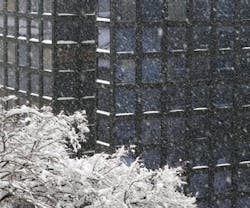Summer’s long, sunny days and the cool, crisp days of fall are the perfect time to do maintenance that protects your roof from winter’s roar.
"Winter is very hard on a roof system due to temperature variation, freeze/thaw conditions, and snow loading," says Kevin Ernster, a registered roof consultant (RRC) and vice-president of Benchmark, Inc. "You want to make sure your roof can tolerate this environment, and make repairs before the snow hits, as it can be very difficult to make repairs to a leaky roof when covered with a couple feet of snow."
The Culprit
The most common cause of winter damage to a roof is the continuous freeze/thaw cycle. This cycle damages the roof by:
1. Affecting the tensile properties of installed materials. This can cause splitting, ridging, and blisters, allowing water to enter into the roof assembly.
2. Ice caused by ponding adds weight that compromises the structural integrity of the roof and can damage the membrane.
3. The "scrubbing" of the roof surface by ice formations that move with the change in temperature can cause considerable damage to the membrane.
4. Exacerbating any defects in the roof – the older and more damaged your roof is, the more effect that freeze/thaw/freeze will have.
In addition, "If your drains are not cleaned, they can become blocked with debris; if water has no place to go, it will build up on the roof," explains Ernster. "The weight of this water, combined with any snow load, can place tremendous pressure on the structure of a building, and can result in collapse."
What You Do to Winterize
Take these three steps to prepare your roof for winter.
1. Locate your leaks. "Identify all active leaks from the building interior and inspect the roof at the leak locations," Ernster says. Leaks are especially difficult to locate with concrete decks, ballasted roofs, and recovered roofs.
2. Inspect in detail. Inspections help outline the conditions of the roof, reveal minor issues before they become leaks, and prepare your roof for the extreme freeze/thaw conditions of a typical northern winter, says Lynn Picone, senior product manager at GAF Materials Corporation. "Many roofing contractors provide this service at a minimal cost, much less than a single typical roof repair." The cost of the inspection is minimal when compared to the cost of repairs needed due to winter damage. "If you hire an inspection, $0.01–.08 cents per square foot should cover winterizing costs, depending on the size and complexity of your roof," explains Ernster.
3. Repair … and prepare. Repair the problems found during the inspection. "You want to do routine repairs, basically ‘button up’ your roof system, so that any point of water entry into the insulation and into the underlying roof system is closed up," explains Mike DeBrincat, director of operations for Building Technology Associates. Make sure perimeter flashings are securely attached. Ensure penetration flashings around ducts, curbs, and skylights are not loose, open at the top, or have any voids in the seams. Sheet metal should be secure and all seam areas should be sealed. Clear all gutters, downspouts, and scuppers, says Picone. Also clean out your drains and make sure they are working properly.
Preparing includes making sure your budget has the money needed for roof repair. "Often times a roof inspection is completed, but money for repairs is not available," says Ernster. "It is important that budgets have an allowance for fall roof repairs."
‘Tis the Season
Start worrying about winterizing your roof before the winter season in your area. "Your geographic location, how early your winter typically begins, and the intensity of your winter dictates starting the winterizing process anytime between September and the end of November," recommends Ernster. You want to allow plenty of time to inspect your roof and make needed repairs. Brisk, fall temperatures are perfect for roofing work. "Typically for roofing work you want temperatures in the 30 degree to 40 degrees or more," he recommends. "However, if the sun is shining, the temperatures can be cooler than this."
If your area escapes cold winter temperatures and snow, that doesn’t mean that your roof can escape the "winterizing" process. "Unless your building is abandoned and you do not care what happens to it, or you live in southern Florida or the southwest desert, winterizing is recommended," Ernster says. "Even in these situations, you should inspect your roof twice a year as if you are planning to winterize it."
Kylie Wroblaski was an associate editor for Buildings.
